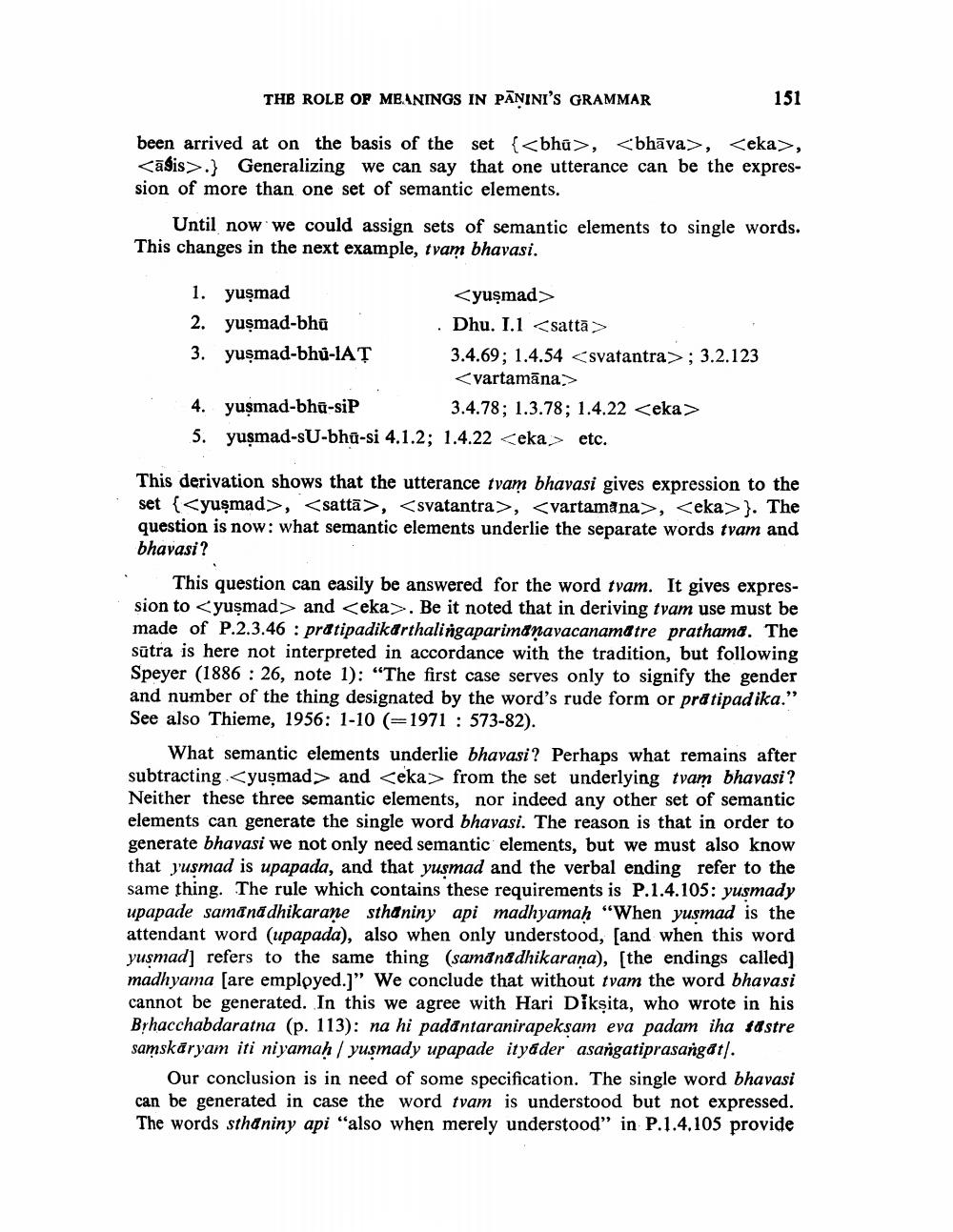Book Title: Role Of Meanings Uin Paninis Grammar Author(s): Johannes Bronkhorst Publisher: Johannes Bronkhorst View full book textPage 6
________________ THE ROLE OF MEANINGS IN PANINI'S GRAMMAR 151 been arrived at on the basis of the set {<bhū>, <bhāva>, <eka>, <āfis>.} Generalizing we can say that one utterance can be the expression of more than one set of semantic elements. Until now we could assign sets of semantic elements to single words. This changes in the next example, tvam bhavasi. 1. yuşmad <yuşmad> 2. yuşmad-bhū . Dhu. I.1 <sattā > 3. yuşmad-bhû-IAT 3.4.69; 1.4.54 <svatantra>; 3.2.123 <vartamāna> 4. yuşmad-bhū-siP 3.4.78; 1.3.78; 1.4.22 <eka> 5. yuşmad-sU-bhū-si 4.1.2; 1.4.22 <eka> etc. This derivation shows that the utterance tvam bhavasi gives expression to the set {<yuşmad>, <sattā>, <svatantra>, <vartamana>, <eka>}. The question is now: what semantic elements underlie the separate words tvam and bhavasi? This question can easily be answered for the word tvam. It gives expression to <yuşmad> and <eka>. Be it noted that in deriving tvam use must be made of P.2.3.46 : pratipadikarthalingaparimaņavacanama tre prathamd. The Sūtra is here not interpreted in accordance with the tradition, but following Speyer (1886 : 26, note 1): "The first case serves only to signify the gender and number of the thing designated by the word's rude form or pra tipad ika." See also Thieme, 1956: 1-10 (=1971 : 573-82). What semantic elements underlie bhavasi? Perhaps what remains after subtracting <yuşmad> and <eka> from the set underlying tvam bhavasi? Neither these three semantic elements, nor indeed any other set of semantic elements can generate the single word bhavasi. The reason is that in order to generate bhavasi we not only need semantic elements, but we must also know that yusmad is upapada, and that yusmad and the verbal ending refer to the same thing. The rule which contains these requirements is P.1.4.105: yusmady upapade samāna dhikarane sthaniny api madhyamah "When yuşmad is the attendant word (upapada), also when only understood, (and when this word yusmad] refers to the same thing (samd nadhikarana), [the endings called] madhyama [are employed.)" We conclude that without tvam the word bhavasi cannot be generated. In this we agree with Hari Diksita, who wrote in his Brhacchabdaratna (p. 113): na hi padantaranirapeksam eva padam iha sestre samskāryam iti niyamah / yuşmady upapade ityader asangatiprasangat). Our conclusion is in need of some specification. The single word bhavasi can be generated in case the word tvam is understood but not expressed. The words sthaniny api "also when merely understood" in P.1.4.105 providePage Navigation
1 ... 4 5 6 7 8 9 10 11 12
